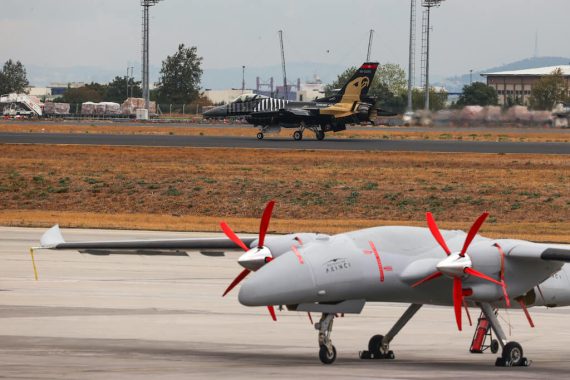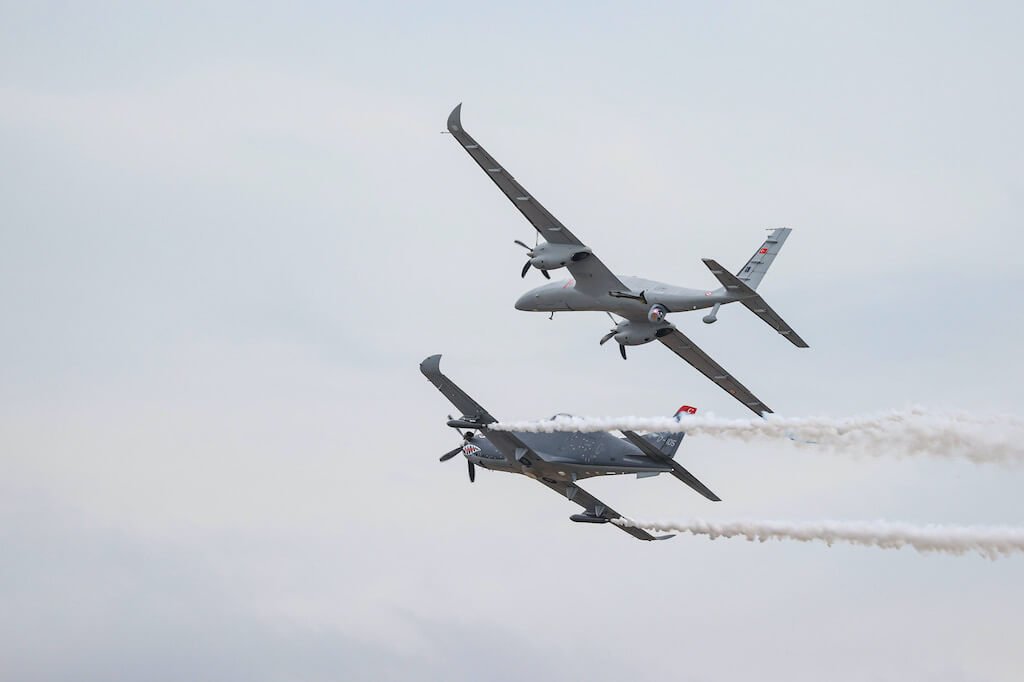On August 29, 2021, Baykar Savunma delivered the first batch of Bayraktar Akinci (Raider) drones to the Turkish Armed Forces (TAF). Designed and developed by Baykar Savunma, Akinci is the latest culmination of the company’s drone development projects. The introduction of Akinci into service is a major milestone in Turkey’s efforts to become a major drone power and leading defense and aerospace technologies developer.
In the past few years, Turkey’s drone industry, its products and their performance in various operations and conflicts have generated great interest. This is especially true in regard to the impact of Anka-S and Bayraktar TB2 armed drones on the Syrian regime forces during Operation Spring Shield in early 2020, which stimulated debates among scholars, observers, and professionals in defense and security circles regarding the future of drones and warfare in general.
As a direct result of their performance in various conflicts, Turkish drones have attracted the interest of numerous countries. Turkey has so far exported Bayraktar TB2 to Qatar, Ukraine, Azerbaijan, Libya, Morocco, and Poland, while Turkish Aerospace Industries has sold Anka to Tunisia. Selçuk Bayraktar, the chief technology officer of Baykar Savunma, has recently stated that the company is in talks with ten countries for the export of Bayraktar TB2.
As a project, Akinci represents the opening of a new chapter for Turkey both in terms of its air power with its new capabilities, and with regard to its aerospace industry by virtue of its new technological competencies.
Akinci and its capabilities
The Bayraktar TB2 is a tactical armed drone, capable of flying at 18,000 feet altitude for up to 27 consecutive hours. The aircraft can carry two or four guided bombs, and is capable of executing a fully autonomous takeoff and landing. Serving the Turkish Armed Forces, the Bayraktar TB2 has fulfilled over 350,000 flight hours since 2014. Having a maximum takeoff weight of around 700 kg, Bayraktar TB2 carries a sophisticated electro-optical camera system to detect and track targets while collecting imagery intelligence (IMINT).
Akinci, on the other hand, is much bigger, heavier, and more sophisticated than Bayraktar TB2. According to the information on the company’s website, Akinci has a maximum takeoff weight of around 6,000 kg, making it the biggest aircraft designed and developed in Turkey. Akinci is powered by two turboprop engines provided by Ukrainian engine manufacturer Ivchenko-Progress. It can carry around 1,500 kg of guided bombs and missiles as well as an electro-optical camera, radar, and various electronic intelligence/signals intelligence (ELINT/SIGINT) sensors. Akinci can remain airborne for approximately 24 hours at 30,000 and 40,000 feet altitude.
Akinci will be equipped with various guided weapon systems among which are the TEBER and MAM (Mini Akıllı Muhimmat or Mini Smart Munition) precision guided bomb systems developed by ROKETSAN; the LGK and HGK precision guidance kits manufactured by ASELSAN; and Bozdoğan short range and Gökdoğan medium range air-to-air missiles developed by TÜBİTAK SAGE.
Akinci will also carry the SOM air-to-surface cruise missile developed by TÜBİTAK SAGE and manufactured by ROKETSAN. With the capability of carrying various types of precision guided weapon systems, Akinci will be able to be used in a wide range of strike missions, ranging from pinpoint surgical strikes to long-range interdictions.
Intelligence and communications
Most importantly, Akinci will be equipped with several intelligence-gathering tools, target detection, and communication systems. Akinci’s main sensor is an electro-optical camera. The drone can carry different types of such sensors including ones developed by ASELSAN. Such cameras use advanced infrared imaging sensors to collect high-resolution imagery from a long range and high altitude.
Also, with the use of laser target designator systems, Akinci can illuminate a target, calculate guidance information for onboard precision weapon systems or pass along that target information to friendly units for strike. The TAF showed remarkable capabilities in executing such complex air-to-surface strike operations in Idlib, Syria and in Libya, and assisted Azerbaijan in achieving the same in Nagorno Karabakh. By virtue of its greater payload-carrying capacity both in terms of weapons and sensors, Akinci will boost the network-centric organization of the TAF.
Akinci will also be equipped with an advanced radar system, under development by ASELSAN. Incorporating active electronically scanned array (AESA) technology, the radar will enable Akinci to detect aerial and ground targets over a long range irrespective of weather. The AESA radar is highly resistant to enemy electronic countermeasures and enables the platform to track several targets simultaneously. Akinci, through onboard air-to-air missiles, can engage with aerial threats on its own or pass along the target information to friendly units, contributing to the update of the strategic air threat scene.
Last but not least, Akinci will be equipped with various types of ELINT/SIGINT sensors, which are extremely crucial in executing strategic intelligence missions during both times of peace and conflict. With its capability of flying for long periods at high altitudes, Akinci will be able to cover large regions around Turkey, collecting intelligence over different segments of the electromagnetic spectrum.
Recommended
All the aforementioned imagery, radar, and electronic intelligence data will be transmitted to the ground control system and other friendly assets through an onboard satellite communications (SATCOM) system developed by ASELSAN. With the help of the SATCOM and Türksat satellites, Akinci can be controlled over an extremely long range, receiving command signals, and sending back all intelligence data. In this way, the SATCOM-equipped Akinci will increase Turkey’s strategic intelligence and strike range.
The transformation of the Turkish aerospace industry
Akinci is the largest air platform to be designed, manufactured, tested, and flown by Turkey. Designing and manufacturing a six-ton drone that is equipped with various sensors and precision guided weapons as well as a ground control system to monitor and control all functions through direct line-of-sight and SATCOM communications data links require advanced skills and know-how in several engineering and project management skill sets.
To establish and maintain a supply chain to manufacture the aircraft and the incorporated ground systems, and deliver them on time to various customers, The Turkish Aerospace Industries and the entire ecosystem of subcontractors and suppliers needed to transform. In other words, Akinci, as well as other ambitious Turkish Aerospace Industries projects such as the TUSAŞ MMU (Milli Muharip Uçağı or National Fighter Jet), Hürjet, and T625 Gökbey, can be considered as catalysts of the transformation of the Turkish aerospace industry. Through the realization of these challenging projects, the Turkish aerospace sector build up the necessary experienced human resources and infrastructure to reinforce and develop its position in the global market.

VIDEO: Turkey’s Defense Industry Making Huge Strides
Akinci epitomizes Turkey’s ambitions of becoming a drone power through indigenous development of advanced technologies and the possession of highly capable systems and platforms. The effectiveness and efficiency of armed drones in counterterrorism operations and in regional conflicts arguably provided enough motivation to decision-makers for devising, planning, and executing a national drone strategy. Starting with the Anka and Bayraktar projects, Akinci is the latest step in this strategy.
Akinci’s impact, both as an armed drone and as an aerospace industry product, for Turkey is worth monitoring. Without a doubt, it will act as a capability multiplier for the Turkish Armed Forces in the short term. Its export performance and role in Turkey’s regional security policies will likely be seen in the medium term.






